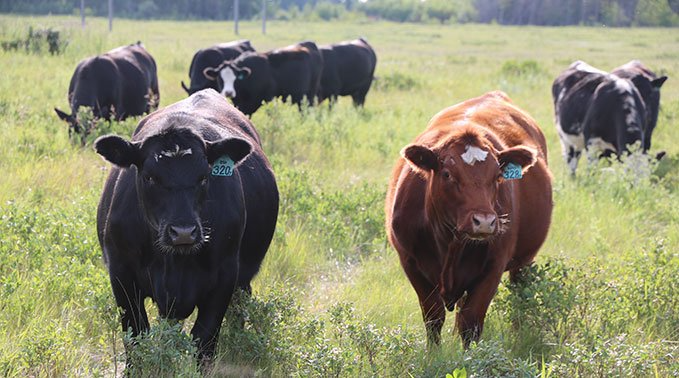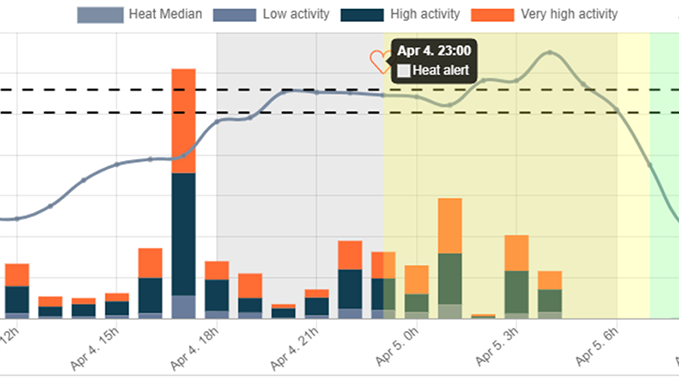Just like we’re told not to judge a book by its cover, don’t judge a heifer solely by her looks.
With the change in the weather and being fall and all, Alberta beef producers are starting to wean calves. For those who retain replacement heifers, weaning includes selecting heifers for the breeding herd, which comes with a price. Just like we’re told not to judge a book by its cover, beef producers shouldn’t judge a heifer solely by her looks

Dr. Susan Markus with Lakeland College Applied Research, along with summer student Katrina Gallan, is working on a Heifer Development project to investigate the use of remote sensing, genomics, and other new technologies to better predict the success (stayability) of a replacement heifer in the cow herd. To date, their checklist includes:
- Conformation – okay, here is where judgment is required. It is important to analyze the feet and legs of the heifer (also evaluate her dam and sire), as those legs and feet need to carry her around for the next six to eight years if she’s going to pay for herself. A producer also needs to evaluate the frame, muscling, and udder and teats of the heifer by evaluating both those of her dam and what her sire has produced in the past. If her mother had udder and teat issues or her father passed on poor conformation, chances are they will be a recurring problem in the herd in the future. “I like having to milk a cow to get the calf started” – said no beef producer ever!
- The heifer needs to be at 55-65 per cent of her mature body weight at breeding. The lower percentage level (55 per cent) of mature body weight works if the heifers are visually exposed to a bull prior to breeding season. The presence of a bull arouses the heifers and can stimulate estrous. If the heifers are to be artificially inseminated (AI’d) and they won’t be seeing a bull, then those heifers likely need to be closer to 65 per cent of their mature body weight when bred.
 Reproductive tract assessment (reproductive tract scoring, RTS, on a scale of one to five) can be done by a qualified vet using ultrasound at a reasonable price, comparable to pregnancy checking. This scan will identify immature or abnormal ovaries and uterus as well as find freemartins. It should be done no more than 60 days before breeding or bull turn out dates. Just because a heifer is born single doesn’t mean she is reproductively sound. Cases have been found where a single-born heifer was a freemartin. The likely explanation is that the heifer had a bull calf sibling, in utero that died and was reabsorbed so was never known. The research found strong correlations between those heifers who ended up open and their RTS being low. It is an excellent assessment to avoid turning reproductively unsound females out to valuable pasture resources for breeding.
Reproductive tract assessment (reproductive tract scoring, RTS, on a scale of one to five) can be done by a qualified vet using ultrasound at a reasonable price, comparable to pregnancy checking. This scan will identify immature or abnormal ovaries and uterus as well as find freemartins. It should be done no more than 60 days before breeding or bull turn out dates. Just because a heifer is born single doesn’t mean she is reproductively sound. Cases have been found where a single-born heifer was a freemartin. The likely explanation is that the heifer had a bull calf sibling, in utero that died and was reabsorbed so was never known. The research found strong correlations between those heifers who ended up open and their RTS being low. It is an excellent assessment to avoid turning reproductively unsound females out to valuable pasture resources for breeding.- Temperament – with time and proper handling, some animals will become more docile but a heifer that is easily excitable likely won’t improve. Based on remote sensing rumen bolus technology that Dr. Markus’ team has implemented in this project which provides daily water intake frequency, internal temperature, and activity indicators to alert for cycling (estrus), the flightier heifers (based on a chute exit score) did not settle after processing and had elevated temperatures, reduced water and/or feed intake for a longer time period, resulting in poorer gains. It always makes for a more pleasant day when animals aren’t jumping fences and getting the rest of the herd riled up.
- Generally, hybrid vigour is an indicator of longevity and efficiency. In a commercial herd, knowing the breed composition of the females allows the manager to mate the females with another breed to maximize hybrid vigour of the offspring. Hybrid vigour is known to improve your weaning weights, disease susceptibility and hardiness of the offspring. Producers have been surprised by the breed compositions of some of their females when they have done a breed composition test. Assuming the breed composition based on coat colour alone fools many of us- it’s something to consider to better sort females into breeding groups.
Original source can be found here.





 Alerts Sign-up
Alerts Sign-up